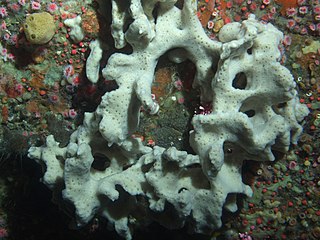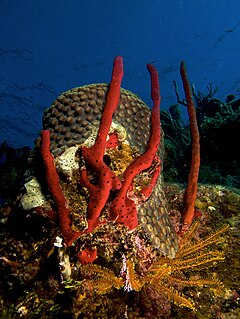
Polymastia is a genus of sea sponges containing about 30 species. These are small to large encrusting or dome-shaped sponges with a smooth surface having many teat-shaped projections (papillae). In areas of strong wave action, this genus does not grow the teat structures, but instead grows in a corrugated form.

Halichondriidae is a family of sea sponges belonging to the order Suberitida. These sponges have a skeleton consisting of dense bundles of spicules occurring in a more or less random pattern.

Halichondria is a genus of sea sponges belonging to the family Halichondriidae. These are massive, amorphous sponges with clearly separated inner and outer skeletons consisting of bundles of spicules arranged in a seemingly random pattern.

Plakinidae is a family of marine sponges. It is composed of seven genera:

Clathria is a large genus of demosponges in the family Microcionidae.

Ircinia is a genus of sea sponges in the family Irciniidae.

Amphimedon is a genus of sponges with over 60 described species. In 2009, Amphimedon queenslandica was the first species of sponge to have its genome sequenced.
Ptilocaulis is a genus of demosponges. The species within this genus are usually red or orange. They are often called tree sponges, as they grow many branches from a single stem resembling trees. They can grow to large size.
Agelas schmidti, commonly known as the brown tubular sponge, is a species of demosponge. It occurs at moderate depths in the Gulf of Mexico and the Caribbean Sea and often has a colonial coral growing over the surface. The type locality is Puerto Rico.

Callyspongia is a genus of demosponges in the family Callyspongiidae.

Neopetrosia proxima is a species of marine petrosiid sponge native to the tropical and subtropical waters of the western Atlantic Ocean.
Neopetrosia is a genus of marine petrosiid sponges. It was first established by the American spongiologist Max Walker de Laubenfels in 1932. It contains these 27 species:
Calthropella is a genus of sea sponges in the order Tetractinellida. It is the only genus in the monotypic family Calthropellidae.

Thorectidae is a family of sea sponges in the order Dictyoceratida.

Agelas tubulata is a species of demosponge. It is tube-shaped or vase-shaped and variable in colour. It is found in the Caribbean area and along the coasts of Brazil at depths of between about 70 and 90 m. It was first described by Lehnert & van Soest in 1996, the type location being the Greater Antilles.
Agelas dispar is a species of demosponge in the family Agelasidae. It lives on shallow-water reefs in the Caribbean Sea and around the West Indies.
Smenospongia is a genus of demosponges in the family Thorectidae.

Mycale is a genus of demosponge with 240 recognised species in 11 subgenera. It has been a large genus with multiple subdivisions since it was first described in 1867.

Phorbas is a genus of demosponges belonging to the family Hymedesmiidae.












